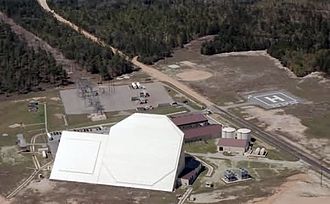Eglin AFB Site C-6
[13] The Air Force developed phased array technology because conventional mechanically rotated radar antennas could not turn fast enough to track multiple ballistic missiles.The beam of a phased array radar is steered electronically without moving the fixed antenna, so it can be pointed in a different direction in milliseconds, allowing it to track many incoming missiles at the same time.In 1975 the deployment by the Soviet Union of submarine launched ballistic missiles (SLBMs), which were also not limited to a northern trajectory and were a greater threat because of the smaller warning time due to their shorter flight path, caused the Air Force to change the primary mission of the radar to SLBM detection and tracking.[6][13] By 1987 the construction of two south-facing PAVE PAWS radar sites in Georgia and Texas took over this workload, and the AN/FPS-85 was returned to full-time spacewatch duties.By altering the relative phase of the radio waves emitted by the individual antennas, the computer can instantly steer the beam to a different direction.[citation needed] The radar beam can be deflected up to 60° from its central boresight axis, allowing it to scan an azimuth (horizontal angle) of 120° and an elevation range from the horizon to 15° past the zenith.The radar operates 24 hours a day, in a rapid repeating cycle 50 milliseconds long (called a "resource period") during which it transmits up to 8 pulses and listens for an echo.)[21] "Following the launching of Sputnik I on 4 October 1957, the Air Force's Missile Test Center at Patrick AFB, Florida, set up·a project[specify] to observe and collect data on satellites."[21] "HQ AFSC decided to give full technical responsibility for the development of a sensor for the 496L Space Track System to RADC…after the Soviet lead in satellite technology in October 1957 and the subsequent failure to locate Explorer XII for six months after it was launched"[21] on 16 August 1961.[28] Site C-6 construction began in October 1962[15] for a system "providing for the possibilities of numerous tube failures by arranging for a large number of people to do replacements" during operations.[29] Before radar testing planned in May 1965, a 5 January 1965 fire due to arcing that ignited dielectric material "almost totally destroyed"[22]: 67 the transmitter/receiver building and contents (the system was insured.)[30] On 22 June 1965 the Joint Chiefs of Staff directed CONAD to prepare a standby plan to also use Site C-6 computer facilities "as a backup" to the NORAD/ADC Space Defense Center "prior to the availability of the AN/FPS-85.

Freeport, FloridaRock Hill rocket sledWalton CountyCoordinatesUnited States Space ForceBendix Corporationradar stationphased arrayU.S. Air ForceSpace Surveillance NetworkCombined Space Operations Centersatellite catalogueJoint Electronics Type Designation SystemCold WarSoviet UnionRussiaFractional Orbital Bombardment Systemintercontinental ballistic missilesgreat circleCuban Missile CrisisNikita KhrushchevSputnikazimuthnuclear strikespace debrisPAVE PAWSsubmarine launched ballistic missilesgeosynchronous orbitvacuum tubestransmitterphase shifterwavelengthbandwidthcrossed-dipole antennaoctagonalinterferenceradio wavessuperimposeplane wavesmain lobezenithIBM ES-9000 mainframe computersSunSparcGeographical Names Information SystemGulf of MexicoAnclote Missile Tracking AnnexAnclote RiverCudjoe Key Missile Tracking AnnexCarrabelle Missile Tracking AnnexSputnik IAir Force's Missile Test CenterPatrick AFBBaltimoreL-bandthe Soviet lead in satellite technology in October 1957submarine-launched ballistic missilearcingJoint Chiefs of StaffSpace Defense CenterDEFCONAN/FSS-7[space] surveillance and tracking modesphase shifters9th Aerospace Defense Division20th Space Control SquadronAir Force Systems CommandAerospace Defense CommandFORTRANSLBM Phased Array Radar Systemfor missile defenseAN/FPS-108Cobra DaneStrategic Air CommandAir Force Space CommandSouthwest Research InstituteLance W. Lord2009 satellite collisionSensitive Compartmented Information FacilityCavalier AFSVHF Space Surveillance FenceL3Harris TechnologiesDepartment of the Air ForceGeographic Names Information SystemUnited States Geological SurveyUnited States Department of the InteriorLincoln Laboratorypublic domainPresident's Science Advisory Committeeballistic missile defensespace surveillanceArmy's BMD projectearly warning systemDefense Support Programat Laredo AFB, Texas (Laredo)in MassachusettsSecretary of the Air ForceJohn StetsonHans Markthe Air Force's Space TrackNavy's SpasurLitton/PRCJOVIALPARC radar facilityGettysburg TimesList of radarsList of military electronics of the United StatesMissile defense in the United StatesAegis Ballistic Missile Defense SystemGround-Based Midcourse Defense (GMD)Terminal High Altitude Area Defense (THAAD)Medium Extended Air Defense System (MEADS)AN/SPY-1AN/TPY-2AN/SPY-3AN/SPY-6 Air and Missile Defense Radar (AMDR)AN/SPY-7 Long Range Discrimination Radar (LRDR)PAVE Phased Array Warning System (PAVE PAWS)Ballistic Missile Early Warning System (BMEWS)AN/FPQ-16 EPARCSAN/FPS-85 Space Track RadarAN/FPS-108 Cobra DaneSolid State Phased Array Radar System (SSPARS)AN/FPS-132 Upgraded Early Warning Radar (UEWR)Sea-based X-band radar (SBX-1)Space-Based Infrared System (SBIRS)Space Tracking and Surveillance System (STSS)